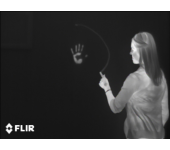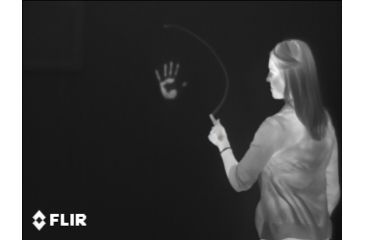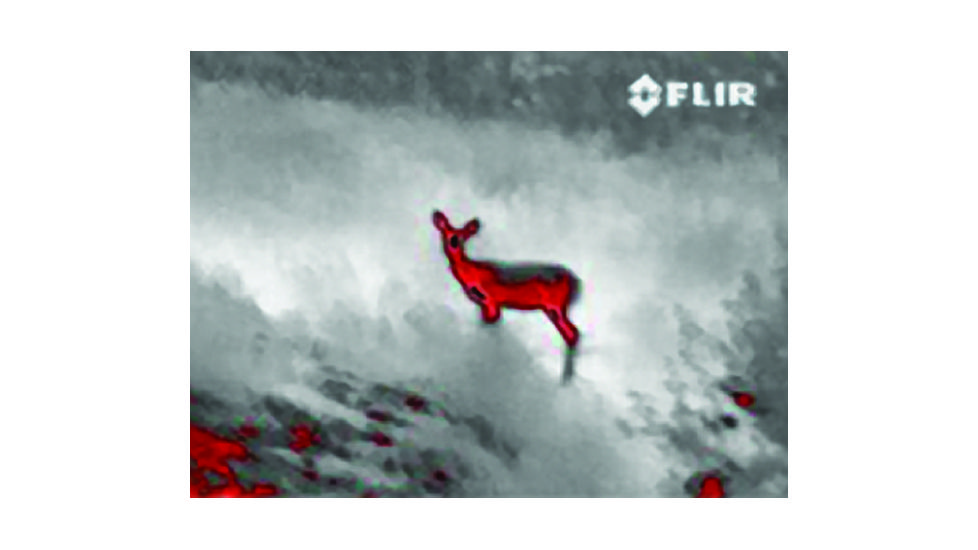Trying to figure out if you need thermal imaging or night vision? While both of these high-tech options are useful, they have unique advantages that make each one better in specific situations. We've put together this guide on the differences and similarities between these two types of optics so that you can decide which is right for you. We'll also provide a few product suggestions so you'll get the best item for your needs.![]()
Thermal Imaging
Thermal imaging devices, also known as thermal imaging cameras, are technically not cameras, but rather sensors that detect heat. Heat is also called thermal energy or infrared radiation. Technically, these devices are detecting radiation. The amount of this radiation goes up with the temperature, allowing you to see a temperature gradient when viewing a thermal imaging device.
With enough precision, a thermal imager can see minute differences in heat and represent this as an image (or thermogram) on a screen. The temperature differences detectable on some of the world's most sophisticated devices can be as small as 0.01°C. A thermal device uses a gradient of colors or black and white to represent temperatures. For black and white thermal images, the lighter the color, the hotter the object. Human beings, animals, and cars generate heat and are usually warmer than their surroundings, allowing the user of a thermal imager to get a good look at them. A coldblooded animal, such as a snake will be harder to see because their body temperature adjusts to their surroundings.
Because they detect radiation, thermal imagers do not require any visible light to produce an image.
Who Uses Thermal Imaging Devices?
Firefighters
Thermal imagers can, to some degree, see through smoke and debris, allowing firefighters to find people who have passed out because of smoke inhalation or children who are hiding and are afraid to come out. A thermal imager can also tell a firefighter if a door is hot and possibly contains a fierce blaze on the other side.
Hunters
Hog hunters are especially fond of thermal imaging devices. Wild hogs are extremely destructive, especially to farms, but they're also clever and dangerous. They rarely go out during the day, and have the benefit of tree or plant cover in many areas. Farmers hunting hogs to protect their farms often use thermal monoculars, binoculars, or rifle scopes. They can see past their crops to find the animal underneath. Hunters also love thermal imagers for finding hidden deer. A popular choice for hunters hoping to spot game is a Thermal Imaging Monocular, which is a lightweight, durable option that allows them to find animals quickly. There are also thermal imaging rifle scopes that you can attach to a rifle and use as a weapon sight! As an easy to carry and use thermal imager, hunters are able to scan the field for long periods of time without arm fatigue. This is an important feature to look for if you plan on using your thermal imager for long periods of time.
Military and Police
Some of the most common users of a thermal imager are law enforcement and military professionals. They need to see potential threats without being detected and thermal units give them this chance. Modern thermal imaging technology is tough enough to withstand the abuse of recoil, so many police officers and soldiers now employ thermal scopes on their firearms. The drawback of using thermal imagers in life-and-death situations is that while they're incredibly effective at detecting people or animals, identification is far more challenging. You may see a man in front of you, but this doesn't mean you can tell if he's a friend or a foe.
Night Vision on left, and Thermal Imaging on the Right. Tree cover does little to hide a person from thermal!
Surveillance
Thermal imaging cameras are one of the most effective tools for surveillance because they work equally well in the day and night. A regular CCTV camera is limited by its need for light, and night vision doesn't function during the day. The chance to see through smoke and fog also gives thermal a leg up on other surveillance techniques.
Energy Audits
Heating and cooling companies have used thermal imagers for years to see where buildings are leaking heat. Small cracks or holes cause homes to lose hundreds of dollars a year on heating and cooling bills.
Deer Spotting
Some manufacturers, like FLIR, now offer thermal imagers that mount behind the grill of a car or anywhere near the front of a vehicle to allow the user to spot deer or other wildlife that can potentially run out into the road. Many people die every year swerving to avoid hitting a deer, and these devices help lessen the danger.
Night Vision
Unlike thermal imagers, image intensification night vision needs at least a small amount of light to operate. If you're hunting or on patrol at night the moon and stars often yield enough light for a good image, but shadows can still make it difficult to see. This means that in a building or cave in complete darkness, a night vision device will not show any more than your naked eye.
To cope with this dependency on ambient light, many people use an IR illuminator with their night vision goggles. These work like flashlights for night vision, but are invisible to the human eye. The one drawback to using an IR illuminator is that they give away your position to anyone else using night vision. This isn't an issue when hunting, but during a tactical operation, this could prove disastrous.
What Are the Uses for Night Vision?
Night vision has been used far more extensively than thermal imagers over the years, but their use is limited to low light situations, as bright light can damage the intensifier tubes that make night vision work. However, this risk is less and less each day as intensifier tube technology improves. The technology has gone through multiple generations, - which you can ready about in our How Does Night Vision Work guide - and the incredible durability of these devices makes them fantastic for many activities.
Hunting Uses
Even first generation night vision rifle scopes with sufficient IR are more than tough enough for not only recoil, but also the kinds of abuse that hunters regularly put their scopes through, and the magnification doesn't distort the image to the point it's unusable. If you plan to use a night vision scope while hunting, check your local laws first. Many states outlaw using night vision for deer hunting, restricting it only to predator and varmint hunting.
Military and Police
Night Vision technology was first developed during World War II, so it's no surprise it's used extensively by the military and police. The ability to see in the dark instantly gives the operator a tactical advantage, and because the best night vision is extremely precise users can identify people they see, even at a distance. Their incredible durability these days makes Night Vision Rifle Scopes extremely reliable. Note that camouflage is often just as effective if not more so with night vision, so if your target blends in with their background well you may struggle to see them. This isn't an issue for thermal imaging.
Camouflage tricks the naked eye and Image Intensification Night Vision, but not Thermal
Is Thermal Imaging or Night Vision Right For Me?

This is a tricky question. There are similar uses for night vision devices and thermal imagers. You'll likely find uses for either item, but here are a few things to consider:
- Price - Cost is going to be a big factor. You can get a good night vision unit for only a few hundred dollars, even weapon-mountable models, but thermal imagers are going to run at least $500, with many being much more than that for a model that you can mount to a rifle and withstand recoil. However, high-end night vision binoculars or goggles are also very expensive, costing several thousand dollars. So if your budget is a bit limited you'll likely choose an image intensification night vision device rather than a thermal imaging device.
- Environment - If you know what conditions you plan on using your thermal imager or night vision unit in that can make a big difference. Is there a lot of fog? Extreme cold? Dense foliage? Heavy fog and foliage necessitate thermal imaging. Extreme cold makes night vision the better choice. The military is starting to create favorable environmental conditions to enhance the effectiveness of their technology. In desert operations, helicopter pilots can kick up mini-sandstorms that thermal imagers are capable of seeing through but the naked eye cannot.
- Light - As image intensification night vision requires light to operate, consider the lighting situation of where you're using it. You won't need a whole lot of light, so even a small amount should work, but make sure you take this into account before investing in night vision when thermal might be better.
- Combine - As already stated, thermal imaging is great for detection, but not ideal for recognition. Night vision has the opposite problem; once an object is detected it's no problem to determine who the person is or what kind of animal it may be, but if that person wears camouflage or the animal stands stationary at a distance it can be difficult to find. A great way to get around these issues is to use a thermal imager to scan the field and a night vision rifle scope to take the shot. Hunters are familiar with this, as using a spotting scope or binocular during the day to find animals before switching to a rifle scope is a common practice. The same principle applies to hunting at night. It's best to use a handheld thermal imager in these situations.
Pros and Cons of Thermal vs. Night Vision
To make things simpler we've put together the following chart of the pros and cons of thermal vision, as well as one of night vision. These lists are comparative, so since both devices help you see in the dark you won't see this point in the pros for either type of optic. Consider these points when you're debating purchasing a thermal imager or night vision device.
| Thermal Images | Night Vision | |||
| Pros | Cons | Pros | Cons | |
| See in any lighting conditions - Day and Night | Image requires some training to interpret | More natural image | Worthless during the day or in lighted rooms | |
| See through smoke/fog/dust/sand | More expensive | Tougher, more reliable | Fog, smoke and dust obscures the image | |
| See through leaves and thin materials | Larger/Heavier | More affordable | Camouflage is often still effective. | |
| Track residual heat (handprints, footprints) | Long start up/warm up time | Wider operational temperature on most models | ||
| Don't produce image for others to see | Nearly impossible to identify an intruder/threat | Wider Field of View (FOV) | ||
| Longer battery life | ||||














